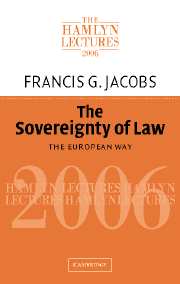Book contents
- Frontmatter
- Contents
- The Hamlyn Trust
- The Hamlyn Lectures
- Preface
- 1 Introduction
- 2 The rule of law in Europe
- 3 The European Convention on Human Rights and the rule of law
- 4 The European Union and the rule of law
- 5 Fundamental values
- 6 Courts and free markets
- 7 The European Union today: some achievements
- 8 The European Union today: some problems
- Afterword
- Index
2 - The rule of law in Europe
Published online by Cambridge University Press: 29 July 2009
- Frontmatter
- Contents
- The Hamlyn Trust
- The Hamlyn Lectures
- Preface
- 1 Introduction
- 2 The rule of law in Europe
- 3 The European Convention on Human Rights and the rule of law
- 4 The European Union and the rule of law
- 5 Fundamental values
- 6 Courts and free markets
- 7 The European Union today: some achievements
- 8 The European Union today: some problems
- Afterword
- Index
Summary
The two European systems: an outline
The two European systems I have referred to in the previous chapter – the European Convention on Human Rights and European Community law – are very different from one another in their substance, and they operate in very different ways. But each, as we shall see, has an important role in reinforcing the rule of law; moreover, by a combination of chance and design, they complement one another.
To summarize in the briefest terms: the European Convention on Human Rights, first conceived in 1950 with much input from the United Kingdom, is binding on the currently forty-six member States of the Council of Europe. The European Court of Human Rights, based in Strasbourg, hears cases brought mainly by individuals, occasionally by corporations, exceptionally even by governments, alleging breach of the human rights guaranteed by the Convention. Cases can be taken to Strasbourg only after all domestic channels of redress have failed. The judgment of the Court, if it finds a breach, is binding on the State against which it is given, and the Court may award compensation.
The European Community, which had its origins also in 1950, now the European Union, is a union of currently twenty-seven Member States. It was initially set up with primarily economic functions, but with political aspirations. It now has competence in many fields, and in most of those fields Community legislation is applied within the Member States.
- Type
- Chapter
- Information
- The Sovereignty of LawThe European Way, pp. 9 - 17Publisher: Cambridge University PressPrint publication year: 2007

